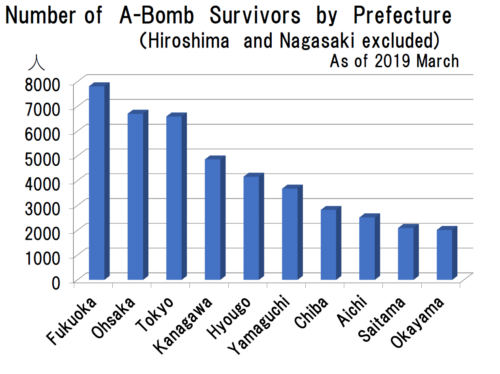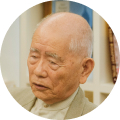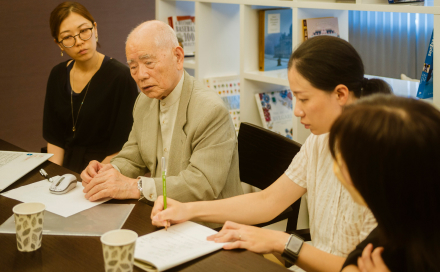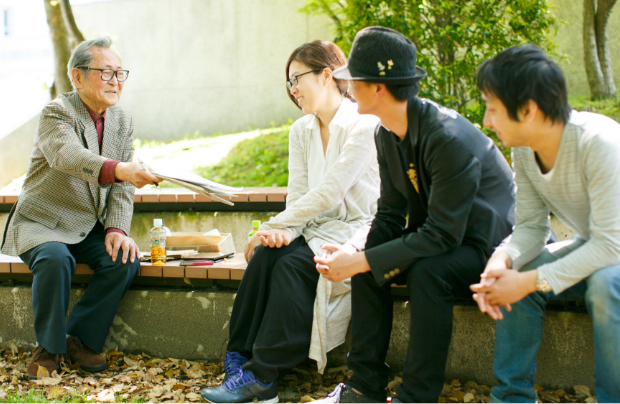HIROSHIMA memory keepers Pass down a story
Vol. 19 2024.9.26 up
I have the sense that many stories concerning the A-bomb seem to start a month or two prior to the bombing, then end two or three months afterwards.
Dr. Nanao Kamada
Emeritus Professor of Hiroshima University

What do people handing down the experience of the A-bombing think and try to convey?
Dr. Nanao Kamada, 87, Emeritus Professor of Hiroshima University, has treated A-bomb survivors for many years as a medical doctor.
We asked him about what he said in his lectures at Hiroshima University and about what he wishes to convey to the future generations.
Section
2040 is “The Limit Year”
Today, I would like to talk to Dr. Kamada, Emeritus Professor of Hiroshima University, who has been supporting survivors over the years from medical perspectives.

Thank you for having me here today.
Dr. Kamada, you have been treating A-bomb survivors for a long time. And, from 2001 to 2017, you spent days and nights together with the survivors as the director of Kurakake Nozomien Home, a nursing home for A-bomb survivors. It will soon be 80 years since the end of World War II. How many survivors are alive today?

As of March, 2023, the number of A-bomb Survivor Health Book bearers is around 110,000.
As you can see from the graph of Population Estimate of A-bomb Survivors in Hiroshima and Nagasaki, the number of the survivors in Hiroshima is going to be just in the thousands in 2040.*
* See “The Current Situation and Future Care for A-bomb Survivors—Medical and Nursing Care Issues,” from the commemorative lecture collection for the 70th anniversary of the Hiroshima Atomic Bomb Casualty Council, September, 2023.

I call 2040 “The Limit Year.”
The average age of survivors in Hiroshima Prefecture is 85.0.
Survivors who were older than five at the time of the A-bombing and are able to talk about their own experiences with no dementia will probably be gone in a few more years.

By the way, do you know which prefecture, besides Hiroshima and Nagasaki, has the largest number of survivors living in it?

Is it Tokyo?

No, it isn’t.It’s actually Fukuoka.
As you can see from the graph of Present Population of Survivors by Prefecture, as of March, 2020, there are approximately 5,500 survivors in Fukuoka, 4,600 in Tokyo, and 3,500 in Kanagawa.
I am surprised that many survivors are living in Fukuoka Prefecture.

There are many Nagasaki survivors in Fukuoka.
Most survivors in Osaka and Yamaguchi are Hiroshima survivors. In Tokyo, 60% are Hiroshima survivors and 40% are Nagasaki survivors.
I would like you to know that you can also hear A-bomb survivors’ testimonies outside of Hiroshima and Nagasaki.
There are four categories of radiation exposure
Dr. Kamada, you have treated survivors since the end of the war. Could you tell us about the physical and psychological problems of the people who were exposed to the A-bombing?

Before talking about survivors, I want you to know that there are four categories of radiation exposure.
The first one is direct exposure.This refers to the state of being directly exposed to neutron rays and gamma rays at the time of the A-bomb explosion.
The second category is entry exposure.This refers to people exposed to radiation from wires and metal after they came into Hiroshima City within two weeks after the A-bombing and within two kilometers from the hypocenter.
The third category is exposure by rescue operation.People were exposed to radiation by inhaling dust when they disposed of bodies killed by the A-bombing or radiation emitted from the metal that might have been on the bodies. Exposure to the black rain falls under this category.
The fourth category is in-utero exposure which is the state of being exposed to radiation in the mother’s womb.
I understand that there are various kinds of exposure.

That’s right.
Let me explain about the physical effects of the people who were directly exposed to radiation.
The energy of the A-bomb consists of blast, heat rays and radiation.
Blast causes bruises, external injuries, hearing loss and so on.
Heat rays cause burns.
It is said when the A-bomb was dropped, the surface temperature of the fire ball reached 7000 to 8000 degrees Celcius.
Those burns eventually turn into keloids.

People who experienced burns on their arm and leg joints may find that their joints become immovable. When people’s Achilles tendon is burned, their ankles are fixed by keloid, which makes it hard to walk.
If people have burns around their mouth, they have difficulty eating.
Even if healthy skin is transplanted, those parts do not heal quickly.Why do you think that is?

Is it because the genes are damaged, and the skin cannot heal over?

That’s right.
Radiation goes through the body and causes genetic abnormality.
Because of this,even if the skin is transplanted, keloids form again.
Six to twelve months after the A-bombing, tissues begin to swell, become rubbery and cause burning pain.
Even 20 years later, keloid symptoms remain. The red parts gradually fade, but they may turn red according to their conditions.
The keloid has a stinging sensation, and sometimes it is hard to sleep at night.
Such symptoms only begin to diminish about 40 years after the A-bombing.
Physical damage from radiation
What kind of damage from radiation is there?

There is physical damage by initial radiation and residual radiation.
Specifically,leukemia, cancer, radiation cataracts, vascular disorders, thyroid disorders and microcephaly are developed due to the abnormality of genes and cells.
The younger the A-bomb exposure age is and the higher the radiation dose is, the higher incidence of leukemia and cancer is.
For these past 20 years, the cases of multiple cancers, developing two or more cancers one by one, have increased.
There are some survivors who developed one cancer after another after the age of 70.
Those, who were exposed to the A-bombing at the age of four to ten, tend to be shorter in height than average.What do you think is the reason?

Is it because their genes were damaged?

Yes. Cells of young people divide more actively.
During a normal growth period, the epiphysial line, the end part of their bones, grows and people become taller. However, if this part is exposed to radiation, cells die, and cell division doesn’t occur.
As a result, usual growth that should happen doesn’t occur in the year when they were exposed to the A-bomb, and their growth is 2 or 3cm shorter than average with no cell division.
Radiation from the Atomic bomb is so horrible. It destroys human bodies down to the cellular level.

When people are exposed to radiation, all inner organs are affected.
A-bomb survivors who look healthy at first may have chromosomal abnormality.
One survivor, who was directly exposed to the A-bombing at the age of 17, developed laryngeal cancer, skin cancer and so on in his later years, and finally died of aspiration pneumonia.
When I treated him, chemotherapy was not yet used for cancer treatment. Radiation therapy was the only treatment available to him.
This patient moaned, saying “More radiation again? I already experienced the A-bomb’s radiation.” His words conveyed his strong feeling that he couldn’t endure any more radiation.
This patient said, “People in the world may know the name, Hiroshima, but they don’t know what is happening in Hiroshima. Let the world know the terrible effects of the A-bombing.”
Psychological damage among A-bomb survivors
We hear that many survivors are suffering from psychological damage.

According to a newspaper survey,23%, or about a quarter of the survivors have not spoken about their experiences of the A-bombing.They cannot talk about it.
Some of my patients have even taken their own lives in their old age.
The first psychological damage that the survivors experienced is “remorse and feeling of guilt,”
the feeling for their failure to save other injured people while they escaped at the time of the A-bombing.They feel convinced that they are bad and sinful people.

The second damage is “infinite fear.”
When they see other survivors around them suffer from various illnesses, they think that it might be their turn next,and if they are women, they constantly worry about infertility and childbirth.
The third damage is “escape from the memories of the A-bomb experiences.”
They are very sensitive to the strong light,the loud BOOM and the smell at the time of the A-bombing.
Some people hate the smell of burning meat.
They say this is because it reminds them of the smell of the cremating corpses.
The fourth damage is “respect and sense of awe for the deceased.”
They believe that those who died in the A-bombing died in their place; therefore, they feel strong anger at any mistreatment of those who died in the A-bombing.
Recently, I have often heard survivors say, “I do not want to cause any more trouble.”
To whom do they mean “I don't want to cause any more trouble?”

To their families.
Survivors often received attentive care from their families for more than a month after the A-bombing.
Many of them say, “I can't cause any more trouble to my family because they took such good care of me at the time of the bombing.”
Some of the survivors we have interviewed so far said that they were discriminated against and bullied simply because they were survivors.

The life of A-bomb survivors can be compared to airplanes. It is like they first took off in a jet plane, but that plane crashed because of the A-bomb.
The survivors then switched to a propeller plane, but they have to continue their life flying at a low altitude.
Students used to come to the A-bomb nursing home where I worked to listen to the residents’ testimonies for peace studies.
After sharing their A-bomb experiences, some residents had flashbacks to past events and could not sleep at night,so I made sure not to ask those residents to talk about their A-bomb or war experiences.
I don’t want to pressure survivors who have had already had painful experiences to talk about them.It is better to wait until they are ready to speak on their own accord.
How the Course for Inheriting Survivors' Experiences started
Many people learn about the days the A-bombs were dropped from textbooks, but are there many people who do not know about what happened afterwards?

I think that’s correct. I once gave a lecture on “War and Peace through the Perspective of Medicine” to students of the Faculty of Medicine at Hiroshima University.
I have the sense that many stories concerning the A-bomb seem to start a month or two prior to the bombing, then end two or three months afterwards.
I think it was probably the first time for the students to hear a first-hand account of the realities of survivors after the A-bombing.
Reference:YouTube https://youtu.be/0nkNUMLzTic?si=4d-lDGnCEtkMRj4X
*Hiroshima University's project on “Medical and Sociological Studies of Short Distance A-bomb Survivors” has been running for 50 years and pursues the lives of survivors themselves, including their physical and psychological changes.
You are also a lecturer at the ANT Course for Inheriting Survivors’ Experiences. Can you share with us what led you to start this course?

When I retired as the director of the Kurakake Nozomien Home, a nursing home for A-bomb survivors, in 2017, I received a letter from one of the nurses there.
In her three-page letter, she shared that she wanted to learn more about the reality of the A-bombing, the survivors and the ongoing problems of A-bomb diseases.
While I was wondering if it would be possible to start a course for people like this nurse who wanted to learn about the A-bomb damage,ANT-Hiroshima, a non-profit organization, made it possible by creating the Course for Inheriting Survivors’ Experiences that would be held seven times over the course of a year.
What kind of people take the course?

Many young people attend the course.
A variety of people including married couples and people from the media, such as TV and newspapers attend the course.
When I find the names of journalists who have graduated from the course in the newspapers, I think, “Oh, they’re working hard,” and it makes me happy.
What does it mean “to inherit the atomic bomb legacy” as your own
What do you want to pass on to the next generation and people abroad?

I would want people to learn in their own way about what the A-bombs did and gain an accurate understanding of exactly what happened.
Then to accept it as their own issue and tell someone else about it.
I think passing on the legacy of A-bomb survivors will be difficult unless we accept this as our own issue and pass it on to others.
What do you think should be done so that the A-bomb and war will be perceived as a personal matter?

What about creating your own family history?
Make a timeline of what your immediate family and relatives were doing around 1945 and what events took place in which year, even if it is by every 10 years.
By comparing your family timeline with the testimonies of the survivors, their stories will begin to make a link.
Placing the survivors in the context of your family history may provide an opportunity to think of them as your own personal matter, rather than as someone else's.
Hearing about the damage caused by the A-bombs from a medical perspective helped us to learn things we did not know.
We would also love for people abroad to hear what you shared with us today.

What I shared today is introduced in the book, One Day in Hiroshima, revised in 2021.
The book has been translated into English, French, German, Spanish and other languages so that it can be read by an international audience.
It is available for anyone to read free of charge via the internet.
One Day in Hiroshimahttps://www.hiroshima.med.or.jp/ippnw/books/
Interviewed on June 2024.
About
"Interviews with HIROSHIMA memory keepers" is a part of project that Hiroshima「」– 3rd Generation Exhibition: Succeeding to History
We have recorded interviews with A-bomb survivors, A-bomb Legacy Successors, and peace volunteers since 2015.

What are Hiroshima memory keepers feeling now, and what are they trying to pass on?

What can we learn from the bombing of Hiroshima? What messages can we convey to the next generation? Please share your ideas.


